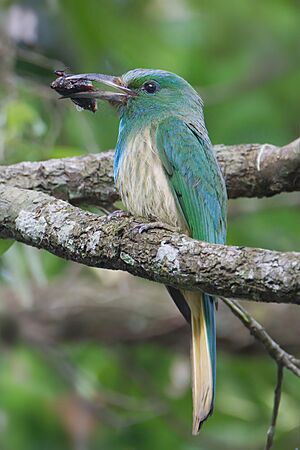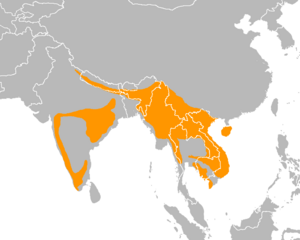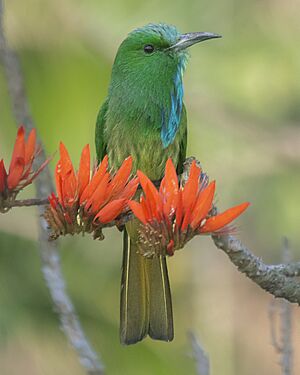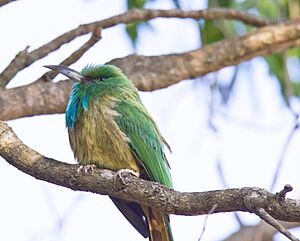Blue-bearded bee-eater facts for kids
Quick facts for kids Blue-bearded bee-eater |
|
|---|---|
 |
|
| Preying on a cicada. Thailand. |
|
| Conservation status | |
| Scientific classification | |
| Genus: |
Nyctyornis
|
| Species: |
athertoni
|
 |
|
| Distribution of the Nyctyornis athertoni | |
| Synonyms | |
|
Merops athertoni |
|
The blue-bearded bee-eater (Nyctyornis athertoni) is a colorful bird found in parts of Asia. You can see it in places like India and Southeast Asia. This bird often lives in clearings within forests. It gets its name from the long, blue feathers on its throat. These feathers often fluff out, making it look like it has a beard!
Blue-bearded bee-eaters have a loud call. However, they are not as social or active as some smaller bee-eaters. Their tail is square-shaped. It does not have the long "wires" that many other bee-eaters have.
Contents
About the Blue-bearded Bee-Eater

This bird is likely the largest type of bee-eater. Adult birds are about 31 to 35 cm (12 to 14 in) long. They weigh between 70 to 93 g (2.5 to 3.3 oz). They have a large, curved beak. Their tail is square, without the long central feathers seen in smaller bee-eaters.
The bird's body is mostly grass green. Its forehead, face, and chin are a pretty turquoise color. The throat feathers are long. When fluffed, they create a "bearded" look. The belly is yellowish or olive. It has streaks of green or blue. Male birds have throat feathers that reflect more ultraviolet light than females.
How it Got its Name
The blue-bearded bee-eater is named after Lieut. John Atherton. He was a relative of P. J. Selby. John Atherton found a specimen of this bird. Selby and Sir William Jardine officially described the species in 1828. They published their findings in a book called "Illustrations of Ornithology."
Different Groups of Bee-Eaters
The main group of blue-bearded bee-eaters lives in India and parts of mainland Southeast Asia. There is also a group called brevicaudatus. This group lives on Hainan Island. Another group, bartletti, from northeastern India, is usually considered part of the main group.
Where They Live
You can find these birds in many different places. They usually live at medium heights, below 2000 meters (about 6,500 feet). They prefer forests that are not too dense, with open areas.
Blue-bearded bee-eaters are often seen alone or in small groups of up to three birds. They are spread out in different areas. This means you might not easily spot them. They have been seen in hill regions of India. These include the Satpuras, Western Ghats, and Eastern Ghats. They also live in the Sub-Himalayan forests.
What They Do
This bird has a loud call. However, it does not call very often. It is also not as active as smaller bee-eaters. Their calls can sound like a cackling hornbill. They also make a dry "Kit-tik... Kit-tik" sound. Sometimes, they make hollow, nasal "kyao" calls. Pairs of birds might sing together. Their songs include cackling and rattling sounds. These end in short purring notes. When they fly, their flight is wavy, similar to a barbet bird.
Nesting and Young
In India, the breeding season is from February to August. During courtship, the birds feed each other. They also bow and fan their tails. They start digging their nest tunnel about a month before laying eggs. The nest is a deep tunnel in a mud bank. Inside, they lay four round, white eggs.
What They Eat
Blue-bearded bee-eaters mostly eat bees. They are clever hunters. They can make Giant honey bee colonies release their guard bees. Then, the bee-eaters catch and eat these guard bees in the air. They usually catch insects while flying. But sometimes, they pick insects off tree bark. They might also join groups of different bird species looking for food. These birds have been seen near Erythrina and Salmalia flowers. It is not clear if they were eating nectar or insects attracted to the flowers.




